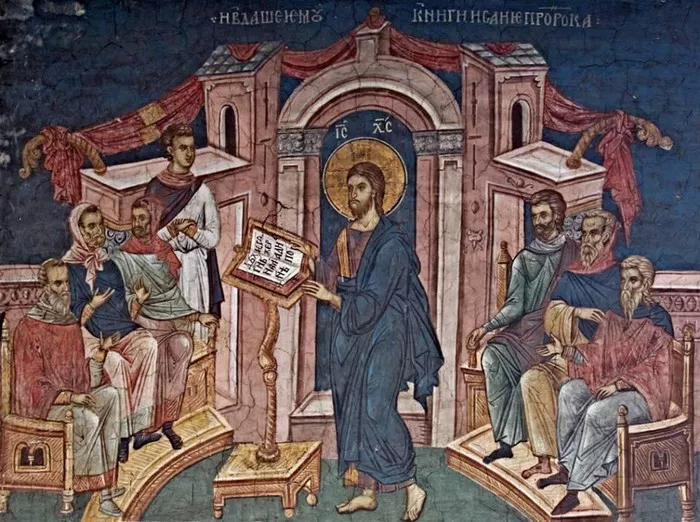Matthew 21:42
BSB:
Jesus said to them, “Have you never read in the Scriptures:
‘The stone the builders rejected
has become the cornerstone.
This is from the Lord,
and it is marvelous in our eyes’?
Verse Explanation: Unlocking the Essence of Matthew 21:42
In Matthew 21:42, Jesus poses a profound question to the religious leaders of his time, quoting Psalm 118:22, “The stone that the builders rejected has become the cornerstone; this was the Lord’s doing, and it is marvelous in our eyes.” At its core, this verse encapsulates the idea of Jesus as the cornerstone, the foundational stone upon which everything else is built.
Contextual Analysis: Understanding the Setting of Matthew 21:42
To grasp the significance of Jesus’ words in Matthew 21:42, it’s crucial to consider the broader context. This passage occurs during the final week of Jesus’ life, commonly known as the Passion Week. In Matthew 21, Jesus triumphantly enters Jerusalem, greeted by crowds waving palm branches and shouting “Hosanna!” This act fulfills Old Testament prophecies, symbolizing Jesus’ role as the long-awaited Messiah.
In the subsequent verses, Jesus cleanses the temple, confronting the corruption that had infiltrated God‘s house. This action further challenges the religious leaders’ authority and exposes their hypocrisy. Amidst this tension, Jesus shares parables, including the one containing verse 42, highlighting the rejection he will face from those in power.
Theological Significance: Delving into the Theological Implications
The metaphor of Jesus as the cornerstone holds profound theological significance. In ancient construction, the cornerstone was the first stone laid, serving as a reference point for aligning the entire structure. Similarly, Jesus is the foundational stone upon which the Church is built (Ephesians 2:20). He is the source of unity, stability, and strength for believers.
Moreover, the rejection of the cornerstone by the builders reflects the rejection of Jesus by the religious authorities of his time. Despite being the fulfillment of prophecy and embodying God’s truth and grace, Jesus was rejected by many who should have recognized and embraced him.
Historical Background: Unveiling the Historical Context
To comprehend the metaphor of the stone and the builders, we must consider the historical backdrop of Jesus’ ministry. During the first century, Israel was under Roman occupation, and religious life was heavily influenced by Pharisaic Judaism. The religious leaders held significant power and authority, often oppressing those they were supposed to lead.
Against this backdrop, Jesus’ teachings and actions challenged the status quo, confronting religious legalism and calling for genuine repentance and faith. His message of salvation and inclusion stood in stark contrast to the exclusivity and self-righteousness of the religious elite.
Cross-References: Exploring Biblical Parallels
The metaphor of the cornerstone appears in various biblical passages, shedding light on its significance. Psalm 118:22, referenced in Matthew 21:42, celebrates the reversal of fortune for the rejected stone, symbolizing God’s sovereignty and wisdom. Ephesians 2:20 further emphasizes the centrality of Christ as the cornerstone in the foundation of the Church, uniting Jews and Gentiles into one body.
Application: Applying Matthew 21:42 Today
Despite its historical context, Matthew 21:42 holds timeless relevance for believers today. Just as Jesus confronted religious hypocrisy in his time, we are called to examine our own lives and attitudes, ensuring that we do not reject Christ in our pursuit of religious practices or cultural norms.
Furthermore, recognizing Jesus as the cornerstone challenges us to prioritize our relationship with him above all else. In a world filled with competing ideologies and distractions, we are reminded that true stability and purpose are found in Christ alone.
Scholarly Commentary: Insights from Biblical Scholars
Biblical scholars offer additional insights into Matthew 21:42, highlighting its symbolic significance and theological depth. Many commentators emphasize the dual nature of Jesus as both the rejected stone and the cornerstone, underscoring the paradox of his earthly ministry.
Moreover, scholars point to the prophetic fulfillment inherent in Jesus’ words, linking his rejection to the broader narrative of salvation history. Through his rejection and subsequent resurrection, Jesus inaugurates a new era of redemption and reconciliation, inviting all people into relationship with God.
Conclusion
In conclusion, Matthew 21:42 serves as a poignant reminder of Jesus’ central role in God’s plan of salvation and the ongoing invitation to embrace him as the cornerstone of our faith. As we meditate on this verse and its implications, may we be inspired to build our lives upon the solid foundation of Christ’s love and grace.


